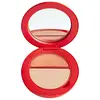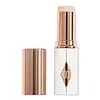Fara Homidi Essential Face Compact Versus Charlotte Tilbury Unreal Skin Sheer Glow Tint Hydrating Foundation Stick
What's inside
What's inside
 Key Ingredients
Key Ingredients

 Benefits
Benefits

 Concerns
Concerns

 Ingredients Side-by-side
Ingredients Side-by-side

Dimer Dilinoleyl Dimer Dilinoleate
EmollientDiisostearyl Malate
EmollientOctyldodecanol
EmollientC10-18 Triglycerides
EmollientC12-15 Alkyl Benzoate
AntimicrobialPolyglyceryl-10 Decaisostearate
EmollientHelianthus Annuus Seed Cera
EmollientJojoba Esters
EmollientPentaerythrityl Tetraisostearate
EmollientCera Microcristallina
Emulsion StabilisingSimmondsia Chinensis Seed Oil
EmollientSodium Hyaluronate
HumectantHelianthus Annuus Seed Oil
EmollientRicinus Communis Seed Oil
MaskingDisteardimonium Hectorite
StabilisingSynthetic Fluorphlogopite
Calcium Sodium Borosilicate
Propylene Carbonate
SolventMica
Cosmetic ColorantCI 77891
Cosmetic ColorantCaprylic/Capric Triglyceride
MaskingSqualane
EmollientTribehenin
EmollientKaolin
AbrasiveOryza Sativa Powder
Ethylhexyl Polyhydroxystearate
EmollientCoco-Caprylate/Caprate
EmollientTheobroma Grandiflorum Seed Butter
Skin ConditioningHydrogenated Ethylhexyl Olivate
EmollientPolyhydroxystearic Acid
EmulsifyingTocopherol
AntioxidantZingiber Officinale Root Extract
MaskingButyrospermum Parkii Butter
Skin ConditioningHydrogenated Castor Oil
EmollientBisabolol
MaskingStearalkonium Hectorite
Gel FormingCI 77491
Cosmetic ColorantCI 77007
Cosmetic ColorantDimer Dilinoleyl Dimer Dilinoleate, Diisostearyl Malate, Octyldodecanol, C10-18 Triglycerides, C12-15 Alkyl Benzoate, Polyglyceryl-10 Decaisostearate, Helianthus Annuus Seed Cera, Jojoba Esters, Pentaerythrityl Tetraisostearate, Cera Microcristallina, Simmondsia Chinensis Seed Oil, Sodium Hyaluronate, Helianthus Annuus Seed Oil, Ricinus Communis Seed Oil, Disteardimonium Hectorite, Synthetic Fluorphlogopite, Calcium Sodium Borosilicate, Propylene Carbonate, Mica, CI 77891, Caprylic/Capric Triglyceride, Squalane, Tribehenin, Kaolin, Oryza Sativa Powder, Ethylhexyl Polyhydroxystearate, Coco-Caprylate/Caprate, Theobroma Grandiflorum Seed Butter, Hydrogenated Ethylhexyl Olivate, Polyhydroxystearic Acid, Tocopherol, Zingiber Officinale Root Extract, Butyrospermum Parkii Butter, Hydrogenated Castor Oil, Bisabolol, Stearalkonium Hectorite, CI 77491, CI 77007
C15-19 Alkane
SolventOctyldodecanol
EmollientTridecyl Trimellitate
EmollientMica
Cosmetic ColorantPentaerythrityl Tetraisostearate
EmollientPolyethylene
AbrasiveBis-Diglyceryl Polyacyladipate-2
EmollientSucrose Tetrastearate Triacetate
EmollientRaphanus Sativus Seed Extract
Skin ConditioningCera Microcristallina
Emulsion StabilisingSilica
AbrasiveSilica Silylate
EmollientHelianthus Annuus Seed Oil
EmollientTocopheryl Acetate
AntioxidantDisteardimonium Hectorite
StabilisingPentaerythrityl Tetra-Di-T-Butyl Hydroxyhydrocinnamate
AntioxidantTriethoxycaprylylsilane
Ricinus Communis Seed Oil
MaskingHydrolyzed Sodium Hyaluronate
Skin ConditioningLupinus Albus Seed Extract
Skin ConditioningDicalcium Phosphate
AbrasiveSodium Hyaluronate
HumectantHydrogenated Castor Oil
EmollientRosmarinus Officinalis Leaf Extract
AntimicrobialTocopherol
AntioxidantTin Oxide
AbrasiveCI 77891
Cosmetic ColorantIron Oxides
CI 42090
Cosmetic ColorantC15-19 Alkane, Octyldodecanol, Tridecyl Trimellitate, Mica, Pentaerythrityl Tetraisostearate, Polyethylene, Bis-Diglyceryl Polyacyladipate-2, Sucrose Tetrastearate Triacetate, Raphanus Sativus Seed Extract, Cera Microcristallina, Silica, Silica Silylate, Helianthus Annuus Seed Oil, Tocopheryl Acetate, Disteardimonium Hectorite, Pentaerythrityl Tetra-Di-T-Butyl Hydroxyhydrocinnamate, Triethoxycaprylylsilane, Ricinus Communis Seed Oil, Hydrolyzed Sodium Hyaluronate, Lupinus Albus Seed Extract, Dicalcium Phosphate, Sodium Hyaluronate, Hydrogenated Castor Oil, Rosmarinus Officinalis Leaf Extract, Tocopherol, Tin Oxide, CI 77891, Iron Oxides, CI 42090
Ingredients Explained
These ingredients are found in both products.
Ingredients higher up in an ingredient list are typically present in a larger amount.
Cera Microcristallina isn't fungal acne safe.
Ci 77891 is a white pigment from Titanium dioxide. It is naturally found in minerals such as rutile and ilmenite.
It's main function is to add a white color to cosmetics. It can also be mixed with other colors to create different shades.
Ci 77891 is commonly found in sunscreens due to its ability to block UV rays.
Learn more about CI 77891Disteardimonium Hectorite comes from the clay mineral named hectorite. It is used to add thickness to a product.
It can also help stabilize a product by helping to disperse other ingredients.
Hectorite is a rare, white clay mineral.
Learn more about Disteardimonium HectoriteHelianthus Annuus Seed Oil is the oil derived from the seeds of a Sunflower. Sunflower seed oil is non-fragrant. It is an emollient, meaning it helps to soften the skin.
Sunflower seed oil contains many fatty acids. The fatty acids found in sunflower seeds include (from highest amount to least): linoleic acid, myristic acid, palmitic acid, stearic acid, arachidic acid, oleic acid, and linolenic acid.
These fatty acids help the skin create ceramides. Ceramides play a role in repairing the skin barrier.
Helianthus Annuus Seed Oil helps moisturize the skin. This in turn helps the skin look more rejuvenated and smoother.
Sunflowers are rich in vitamin E.
Historians believe Indigenous cultures of North America domesticated sunflowers before corn. Thus they relied on sunflower oil for a variety of uses. One such use is moisturizing skin and hair.
Sunflower seed oil may not be fungal acne safe. We recommend speaking with a professional if you have any concerns.
Learn more about Helianthus Annuus Seed OilHydrogenated Castor Oil is created by adding hydrogen to castor oil. This helps stabilize the castor oil and raises the melting point. At room temperature, hydrogenated castor oil is solid.
Castor Oil helps moisturize the skin. It is rich in a fatty acid called ricinoleic acid. This fatty acid helps prevent moisture loss on the skin. This helps keep your skin soft and hydrated. Ricinoleic acid also has anti-inflammatory and pain reducing properties.
As a wax-like substance, Hydrogenated Castor Oil acts as an emollient. Emollients help keep your skin stay soft and smooth by creating a barrier. This barrier helps trap moisture.
Hydrogenated Castor Oil may not be fungal-acne safe. We recommend speaking with a professional.
Learn more about Hydrogenated Castor OilMica is a naturally occurring mineral used to add shimmer and color in cosmetics. It can also help improve the texture of a product or give it an opaque, white/silver color.
Serecite is the name for very fine but ragged grains of mica.
This ingredient is often coated with metal oxides like titanium dioxide. Trace amounts of heavy metals may be found in mica, but these metals are not harmful in our personal products.
Mica has been used since prehistoric times throughout the world. Ancient Egyptian, Indian, Greek, Roman, Aztec, and Chinese civilizations have used mica.
Learn more about MicaOctyldodecanol is a fatty alcohol. It is primarily used to enhance the texture of products.
As an emulsifier, Octyldodecanol helps prevent the oils and waters from separating. It also prevents ingredients from creating foam when shaken.
Octyldodecanol is created by reducing fatty acid to an alcohol.
Due to its high molecular weight, it does not get absorbed into the skin.
Learn more about OctyldodecanolPentaerythrityl Tetraisostearate is derived from isostearic acid. It is an emollient and emulsifier.
The highest concentration of this ingredient is found in lipsticks.
This ingredient is minimally water soluble and may not be Malassezia folliculitis, or fungal-acne safe.
Learn more about Pentaerythrityl TetraisostearateRicinus Communis Seed Oil is the INCI name for castor oil.
Castor Oil helps moisturize the skin. It is rich in a fatty acid called ricinoleic acid. This fatty acid helps prevent moisture loss on the skin. This helps keep your skin soft and hydrated. Ricinoleic acid also has anti-inflammatory and pain reducing properties.
Besides hydrating the skin, castor oil is also used to hydrate hair. By keeping the hair shaft moisturized, breakage is decreased. More studies are needed to show castor oil's effective on stimulating hair growth.
Castor oil is created by cold-pressing castor seeds and then purifying the oil with heat. It was used in Ancient Egypt as fuel in lamps and to help treat eye irritation.
The term 'fragrance' is not regulated in many countries. In many cases, it is up to the brand to define this term. For instance, many brands choose to label themselves as "fragrance-free" because they are not using synthetic fragrances. However, their products may still contain ingredients such as essential oils that are considered a fragrance.
Learn more about Ricinus Communis Seed OilSodium Hyaluronate is hyaluronic acid's salt form. It is commonly derived from the sodium salt of hyaluronic acid.
Like hyaluronic acid, it is great at holding water and acts as a humectant. This makes it a great skin hydrating ingredient.
Sodium Hyaluronate is naturally occurring in our bodies and is mostly found in eye fluid and joints.
These are some other common types of Hyaluronic Acid:
Learn more about Sodium HyaluronateTocopherol (also known as Vitamin E) is a common antioxidant used to help protect the skin from free-radicals and strengthen the skin barrier. It's also fat soluble - this means our skin is great at absorbing it.
Vitamin E also helps keep your natural skin lipids healthy. Your lipid skin barrier naturally consists of lipids, ceramides, and fatty acids. Vitamin E offers extra protection for your skin’s lipid barrier, keeping your skin healthy and nourished.
Another benefit is a bit of UV protection. Vitamin E helps reduce the damage caused by UVB rays. (It should not replace your sunscreen). Combining it with Vitamin C can decrease sunburned cells and hyperpigmentation after UV exposure.
You might have noticed Vitamin E + C often paired together. This is because it is great at stabilizing Vitamin C. Using the two together helps increase the effectiveness of both ingredients.
There are often claims that Vitamin E can reduce/prevent scarring, but these claims haven't been confirmed by scientific research.
Learn more about Tocopherol